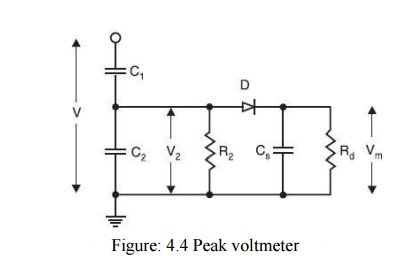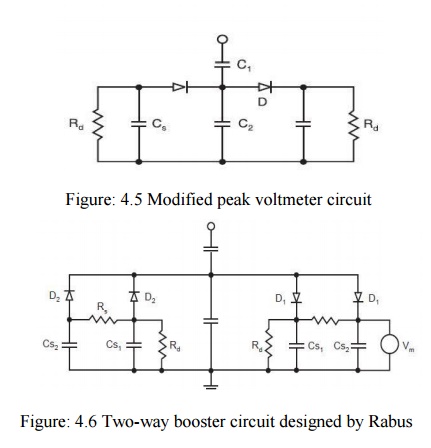Passive circuits are not very frequently used these days for measurement of the peak value of a.c. or impulse voltages. The development of fully integrated operational amplifiers and other electronic circuits has made it possible to sample and hold such voltages and thus make measurements and, therefore, have replaced the conventional passive circuits. However, it is to be noted that if the passive circuits are designed properly, they provide simplicity and adequate accuracy and hence a small description ofthese circuits is in order. Passive circuits are cheap, reliable and have a high order of electromagnetic compatibility. However, in contrast, the most sophisticated electronic instruments are costlier and their electromagnetic compatibility (EMC) is low. The passive circuits cannot measure high voltages directly and use potential dividers preferably of the capacitance type. Fig. 4.4.1 shows a simple peak voltmeter circuit consisting of a capacitor voltage divider which reduces the voltage V to be measured to a low voltage Vm.

Suppose R2 and Rd are not present and the supply voltage is V. The voltage across the storage capacitor Cs will be equal to the peak value of voltage across C2 assuming voltage drop across the diode to be negligibly small. The voltage could be measured by an electrostatic voltmeter or other suitable voltmeters with very high input impedance. If the reverse current through the diode is very small and the discharge time constant of the storage capacitor very large, the storage capacitor will not discharge significantly for a long time and hence it will hold the voltage to its value for a long time. If now, V is decreased, the voltage V2 decreases proportionately and since now the voltage across C2 is smaller than the voltage across Cs to which it is already charged, therefore, the diode does not conduct and the voltage across Cs does not follow the voltage across C2. Hence, a discharge resistor Rd must be introduced into the circuit so that the voltage across Cs follows the voltage across C2. From measurement point of view it is desirable that the quantity to be measured should be indicated by the meter within a few seconds and hence Rd is so chosen that RdCs ≈ 1 sec. As a result of this, following errors are introduced. With the connection of Rd, the voltage across Cs will decrease continuously even when the input voltage is kept constant. Also, it will discharge the capacitor C2 and the mean potential of V2 (t) will gain a negative d.c component. Hence a leakage resistor R2 must be inserted in parallel with C2 to equalize these unipolar discharge currents. The second error corresponds to the voltage shape across the storage capacitor which contains ripple and is due to the discharge of the capacitor Cs. If the input impedance of the measuring device is very high, the ripple is independent of the meter being used. The error is approximately proportional to the ripple factor and is thus frequency dependent as the discharge time constant cannot be changed. If RdCs = 1 sec, the discharge error amounts to 1% for 50 Hz and 0.33% for 150 Hz. The third source of error is related to this discharge error. During the conduction time (when the voltage across Cs is lower than that across C2 because of discharge of Cs through Rd) of the diode the storage capacitor Cs is recharged to the peak value and thus Cs becomes parallel with C2. If discharge error is ed, recharge error er is given by

Hence Cs should be small as compared withC2 to keep down the recharge error. It has also been observed that in order to keep the overall error to a low value, it is desirable to have a high value of R2. The same effect can be obtained by providing an equalizing arm to the low voltage arm of the voltage divider as shown in Fig. 4.4.2 This is accomplished by the addition of a second network comprising diode, Cs and Rd for negative polarity currents to the circuit shown in Fig.4.4.3 With this, the d.c currents in both branches are opposite in polarity and equalize each other. The errors due to R2 are thus eliminated. Rabus developed another circuit shown in Fig. 4.4.4 to reduce errors due to resistances. Two storage capacitors are connected by a resistor Rs within every branch and both are discharged by only one resistance Rd.

Here because of the presence of Rs, the discharge of the storage capacitor Cs2 is delayed and hence the inherent discharge error is reduced. However, since these are two storage capacitors within one branch, they would draw more charge from the capacitor C2 and hence the recharge error would increase. It is, therefore, a matter of designing various elements in the circuit so that the total sum of all the errors is a minimum. It has been observed that with the commonly used circuit elements in the voltage dividers, the error can be kept to well within about 1% even for frequencies below 20 Hz. The capacitor C1 has to withstand high voltage to be measured and is always placed within the test area whereas the low voltage arm C2 including the peak circuit and instrument form a measuring unit located in the control area. Hence a coaxial cable is always required to connect the two areas. The cable capacitance comes parallel with the capacitance C2 which is usually changed in steps if the voltage to be measured is changed. A change of the length of the cable would, thus, also require recalibration of the system. The sheath of the coaxial cable picks up the electrostatic fields and thus prevents the penetration of this field to the core of the conductor. Also, even though transient magnetic fields will penetrate into the core of the cable, no appreciable voltage (extraneous of noise) is induced due to the symmetrical arrangement and hence a coaxial cable provides a good connection between the two areas. Whenever, a discharge takes place at the high voltage end of capacitor C1 to the cable connection where the current looks into a change in impedance a high voltage of short duration may be built up at the low voltage end of the capacitor C1 which must be limited by using an over voltage protection device (protection gap). These devices will also prevent complete damage of the measuring circuit if the insulation of C1 fails.

